
Jumps and Ribbons and Zoomies:
Choosing Agility Photos by Rebecca Forrest
When your dog competes in an agility trial, you often have the opportunity to purchase action photos from a professional photographer. Depending on the length of your dog’s run, the lighting conditions, and the methods used by the photographer, you may have a few shots to choose from—or you may have forty or fifty choices per run.
How in the world do you choose the photos to buy?
Here are some guidelines to help you with those decisions.
Choose quality. First, look at each shot carefully and in the best possible light. If you’re reviewing images on a screen, zoom in (or ask the salesperson to do that) to check for clarity. If you’re looking at printed photos, hold them up and examine them closely.
Look at every shot. Even a photo that you don’t choose to buy might tell you something about why things went well or badly.
For buying agility photography, the ideal is to find images where all these things are true:
-
•At least your dog’s face is in focus. Other parts (ears, legs, tail, jump) may well be blurry if the dog is in motion. The real test of focus for a dog’s face is the eyes.
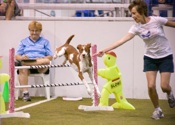
-
•The dog is adequately lit. For example, his face isn’t in deep shadow.
-
•Your dog is clearly visible. That is, she’s not obscured by jump standards, people, etc.
-
•Your dog looks the right color—for example, your white dog isn’t pink or green, or your black dog isn’t brown or gray.

-
•Your dog looks the same color in different parts of the ring, which is especially difficult at indoor events. Although the photographer should manually balance all colors across all photos, he or she should especially try to make your dog look consistent, even if the color of your clothing seems to change from shot to shot. Check out the two shots at the right--the handler’s shirt is pinkish in one of them and bluish in the other, but the dog’s color is consistent.
-
•Solid colors in the picture look solid, not grainy. Of course, with poor lighting conditions, grain may be unavoidable.
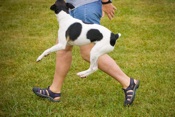
-
•No part of your dog is cut off at the edge of the frame. And your dog is positioned well inside the edge of the photo. You wouldn’t want to frame the picture and find that the frame blocks his nose, his foot, or the top of his head. Here’s a great shot, but it’s missing a nose!
-
•At trials with poor lighting (indoors or early or late in the day outdoors), you’ll probably find that the shots are better when your dog is moving more slowly. At better illuminated trials, you can go for the faster action shots.
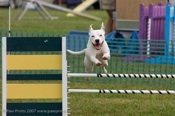
-
•Get some head-on shots of your dog coming over a jump.
-
•Look for shots showing your dog’s form as a jumper—all four legs extended, or front legs extended and hind legs tucked, etc. These are usually profile or three-quarter shots. Also get shots that show your dog’s leap up to a jump and banked turn on landing.
-
•Choose shots where your dog is framed inside an obstacle like a tire jump or atunnel.
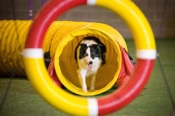
-
•Find shots that show your dog hitting her contact points.
-
•Choose shots that show your dog twisting through the weaves. These might be from the front, the side, or the back.
-
•On a great or terrible run, get a photo that shows the electronic timer in the background.
-
•Get some shots of your dog at the apex of the A-frame.
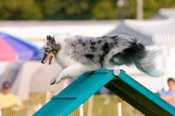
-
•Look for shots that reveal your dog’s personality—back-talk, distraction, exuberance, whatever.
-
•Choose shots that especially show teamwork between you and your dog.

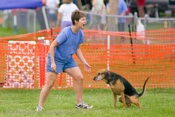


-
•Find photos that show your dog’s beautiful—or dreadful—start-line stay.
-
•Get dramatic, but often overlooked shots, like the leap onto the A-frame, the skid across the table, or the banked turn in the middle of the field.

-
•Go for the follow-on photos of the two of you during your victory lap, the hug from the judge, and your dog with his ribbons.
-
•And above all, get the shots that show you and your dog interacting—you giving clear direction over a jump, you convincing him to enter a tunnel,her taking a triumphant leap into your arms, you chasing him when he’s got the zoomies, you carrying her out of the ring.
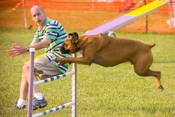

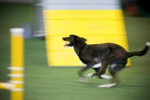
Finally, get the right photo processing services. Good-quality photos are important, but so are other things. For example:
-
•You might want custom-cropping to zoom in on your dog as she charges out of a tunnel. Or you might want a photo cropped to fit a certain frame. (If that’s the case, be sure to bring the exact inside-frame dimensions with you. And be aware that not every picture can be cropped to every size frame.)
-
•You should also expect consistency from photos taken in similar circumstances. Even though the lights in an arena might vary from blue to pink to yellow, a good photographer should be able to color-balance your shots so that your dog doesn’t seem to change from purple to brown to green from image to image.
-
•You should expect your photos to last a long time, given reasonable care. For that reason, buy photos that are professionally printed with archival inks on archival paper.
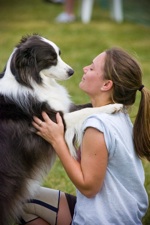
So, as it turns out, agility really isn’t only about jumps and ribbons and zoomies. It’s also about the bond between you and your dog.
Written by Rebecca Forrest
All photos by Virgil Sweeden,
Paw Prints Pet Photography (of course!)